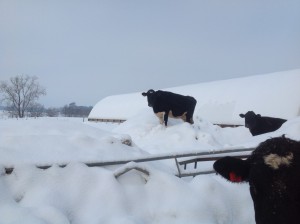By Sarah Mahan of This Farm Family's Life
Meggie Foster and her husband, Dallas, live in Greenfield
along with their two daughters, Reagan, 4, and Ruby, 1. Dallas and Meggie are proud to be raising
their daughters on their family farm.
Meggie works full-time off-farm for Indiana Farm Bureau where she works
with young farmers and women’s program leaders.
She explains that, in their free time, they love to spend time with
their family, travel and attend cow shows.
Meggie grew up on a registered Jersey farm in central Ohio and still owns
a small herd of registered Jersey cows.

The Fosters farm in Hancock County and Rush County as well
as Meggie’s family farm in Marion County, Ohio.
“Dallas is the fifth generation to farm in Indiana, and I am the sixth
generation farmer in my family. Dallas’
family raised purebred hogs and sheep for many years before transitioning to
commercial hogs in the mid-1990s.
Beginning in the 1920s, the Foster family traveled the country showing
purebred sheep and swine, hosting hog sales at the home farm in the 1980s,
inviting special guests such as Vice President Dan Quayle and Secretary of
Agriculture Earl Butz. Dallas’ father
liquidated the hog herd in 2005, and Dallas and I began our farming operation
the following year. We have grown our
farm from a 50-sow, single-site farm to a 600-sow multi-site operation today.”
Meggie looks back on her childhood and feels blessed to have
had the opportunity to grow up on a farm.
“While my classmates played video games, I was outside playing with the
pony, the dogs or my pet goat. I have
always loved animals and exploring outside.
I absolutely loved feeding the baby calves and working alongside my dad,
milking the cows. I feel blessed that I
grew up on the farm learning the meaning of responsibility--caring for the land
and the animals. I hope to instill the
same sense of responsibility in my girls.”
When asked what she feels is one of the biggest challenges
farmers face today, Meggie has a hard time narrowing it down to just one. “Farmers face challenges every day, wondering
if we will get too much rain or not enough to grow our crops. The considerable over-regulation of livestock
farms by government agencies and volatility in the grain and hog markets are
additional challenges. In addition, the
growing distrust by consumers has many farmers concerned about the future, but
I’m confident that farmers will make mindful and sustainable adjustments in
production to continue to provide enough healthy food to feed the world.”
With many consumers being about three generations removed
from the farm, Meggie wishes that they could all have the opportunity to meet
the farmers behind their food. She wants
consumers to know that food is not raised in a factory; food is grown by family
farmers across the country. “Animals are
raised with caring hands and hearts. I
want the consumers to know the generations of family farmers who have inspired
improvements in how we farm and that those improvements created the
efficiencies that allow farmers to provide the best care possible to their
livestock and to spend just a little more time with their families. I want them to know how many farmers woke up
earlier than usual to milk the cows before their kids woke up on Christmas
morning to unwrap Christmas presents. I
want them to know that farmers are just like you and want a healthy and safe
food supply more than anyone.”
When four-year-old Reagan was asked what is her favorite
part of living on a farm, her reply was, “Riding in the tractor with my daddy,
especially when he lets me drive!”
Meggie echoes that sentiment by saying, “I feel very blessed to raise
our girls on the family farm. I want our
girls to grow up with a good work ethic as demonstrated by their dad; and learn
responsibility through caring for their own animals in the 4-H program. I want our girls to discover the joy in
farming and also understand how to learn and grow from challenges along the
way.”





.JPG)
.JPG)